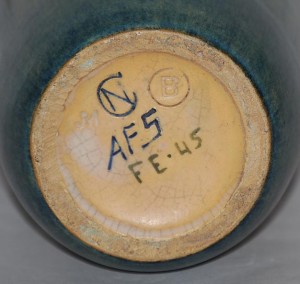
My ceramics class at LSUA is going quite well this semester. Some of the students are hand building pots, while others are at the wheel learning to throw. It is a skill not easily accomplished. I have seen some students over the years that have a natural skill for working the wet clay into a beautiful shape through controlled, but fluid, motion. Others struggle to maintain control of the clay while letting it develop into the desired shape without force. The students in my class this fall are all women. That fact reminds me of the Newcomb College Pottery that gained an international reputation as one of the most significant potteries in the first half of the 20th century.
Newcomb College was established in 1886 as an institution of higher learning for women that stressed education both “practical and literary”. Noted potter, Ellsworth Woodward, came to Newcomb to establish the pottery in 1894. He hired Mary Given Sheerer to teach decoration.

Records indicate that the first piece of Newcomb pottery was sold in 1896. It was decorated by Selina Bres and sold to a buyer in Boston for $4.00. By 1901, pots were being sold internationally. In that same year, a lamp was sent from the Pottery to a buyer in Berlin for $6.00. With successful sales underway, Woodward convinced the College to construct a second building that included a large sales room. Students, craftsmen, and faculty could thereby make a modest living from their art works. It is important to note that the Newcomb Pottery produced art ceramics and not functional ware. Students often remained after graduation as “Craftsmen”. This was a position awarded to the women to continue their work at the Newcomb Pottery, selling their works in the Pottery sales room.

Harriet Joor (1875-1965) graduated in the first class to work with Mary Sheerer in 1895. After graduation, she taught at the University of Chicago until she returned to Louisiana in the late 1920’s to join the faculty of ULL. A 12” blue and green floral vase, decorated in 1904, sold at auction on October 12, 2001, for $42,550.
Marie de Hoa LeBlanc (1874-1954), daughter of an old New Orleans Creole family, came to Newcomb College with her sister, Emilie. Both worked in the Pottery. Having a gift for languages, both sisters studied pottery in Europe, working in Paris and Munich. Marie also taught at Newcomb. A 12” iris vase, decorated in 1909 by Marie, sold at auction on December 8, 2001, for $28,750.
The largest auction sales have been generated by the works of Henrietta Bailey (1874-1950.) Bailey graduated from Newcomb and worked as a Craftsman from 1904-1926. She was awarded a faculty position in 1926. Bailey taught at Newcomb until 1938. A 16” morning glory vase, decorated in 1907, sold at auction on April 8, 2000, for $82,500. Her 8” pine cone vase, decorated in 1930, sold at auction in 2003 for $88,000.
There are even some works of Mary Sheerer, founding teacher of decorating, still around and being auctioned. Her 9” blue/green vase, decorated in 1898, sold on February 23, 2008, for $29,400.
You never really know where a Newcomb pot is going to turn up for sale. Works sell at auction for the highest prices, but often a Newcomb pot is discovered at a garage or estate sale for an insanely low cost. The sellers of Grandma’s “dust catchers” simply do not know that a vase can be worth so much money. It inspires us to check out those local Saturday morning sales!










